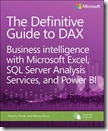Sample chapter: Understanding Evaluation Contexts in DAX
 This chapter from The Definitive Guide to DAX: Business intelligence with Microsoft Excel, SQL Server Analysis Services, and Power BI covers evaluation contexts, which are the basis of all of the advanced features of DAX.
This chapter from The Definitive Guide to DAX: Business intelligence with Microsoft Excel, SQL Server Analysis Services, and Power BI covers evaluation contexts, which are the basis of all of the advanced features of DAX.
At this point in the book, you have learned the basics of the DAX language. You know how to create calculated columns and measures, and you have a good understanding of common functions used in DAX. This is the chapter where you move to the next level in this language: After learning a solid theoretical background of the DAX language, you will be able to become a real DAX champion.
With the knowledge you have gained so far, you can already create many interesting reports, but you will need to learn evaluation contexts in order to create reports that are more complex. Evaluation contexts are the basis of all of the advanced features of DAX.
We want to give a few words of warning to our readers: The concept of evaluation context is an easy one, and you will learn and understand it soon. Nevertheless, you need to thoroughly understand several subtle considerations and details. Otherwise, you will feel lost at a certain point during your DAX learning path. We teach DAX to many users in public and private classes. We know that this is absolutely normal. At a certain point—you have the feeling that formulas work like magic, because they work, but you do not understand why. Do not worry: you will be in good company. Most DAX students reach that point and many others will reach it in the future. It simply means that evaluation contexts are not clear enough to them. The solution, at that point, is an easy one: Come back to this chapter, read it again, and you will probably find something new, which you missed during your first read.
Moreover, evaluation contexts play an important role with the usage of the function CALCULATE, which is probably the most powerful and hard-to-learn function in DAX. We will introduce CALCULATE in Chapter 5, “Understanding CALCULATE and CALCULATETABLE,” and then use it through the rest of the book. Understanding CALCULATE without having a solid background on evaluation context is problematic. On the other hand, understanding the importance of evaluation contexts without having ever tried to use CALCULATE is nearly impossible. Thus, this chapter and the subsequent one are the two that, in our experience with the previous books we have written, are always marked up and have the corners of pages folded over.
Read the complete chapter here .